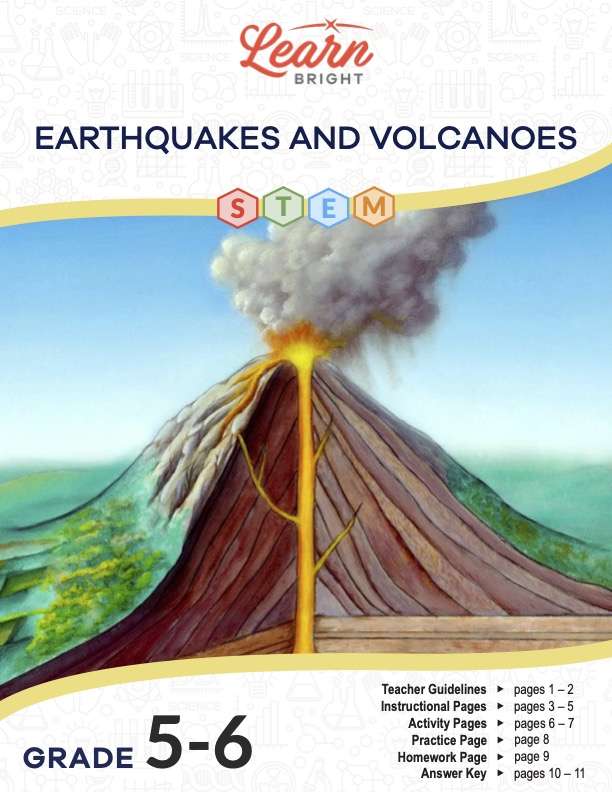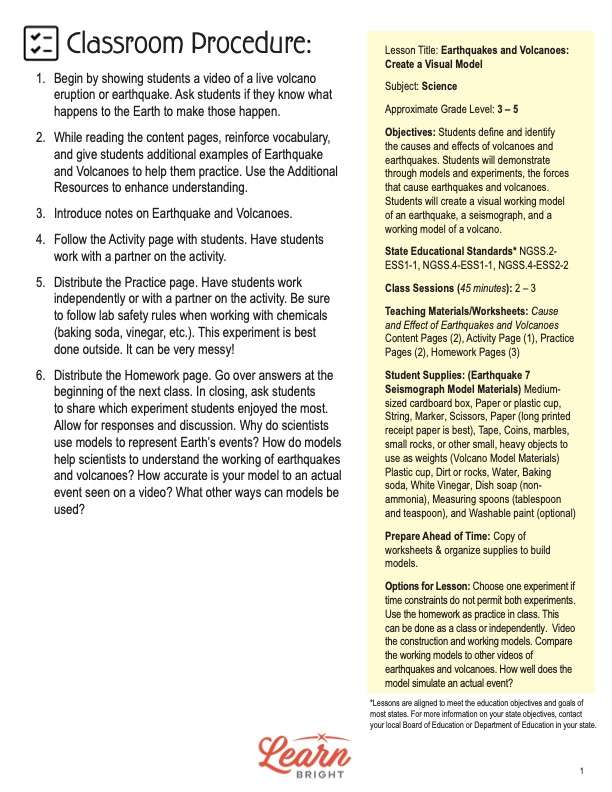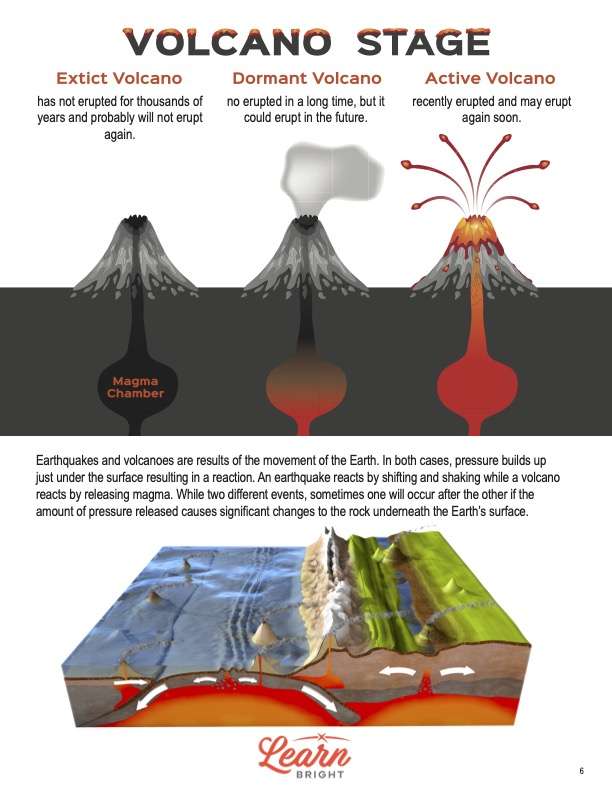Description
What our Earthquakes and Volcanoes STEM lesson plan includes
Lesson Objectives and Overview: Earthquakes and Volcanoes STEM defines and explains the causes and effects of these destructive natural disasters. Students will create a visual working model of a seismograph and earthquake and of a volcano. They will be able to demonstrate the forces that cause these events through experiments with these models. This lesson is for students in 3rd grade, 4th grade, and 5th grade.
Classroom Procedure
Every lesson plan provides you with a classroom procedure page that outlines a step-by-step guide to follow. You do not have to follow the guide exactly. The guide helps you organize the lesson and details when to hand out worksheets. It also lists information in the yellow box that you might find useful. You will find the lesson objectives, state standards, and number of class sessions the lesson should take to complete in this area. In addition, it describes the supplies you will need as well as what and how you need to prepare beforehand.
Options for Lesson
The “Options for Lesson” section of the classroom procedure page provides a number of suggestions for things you can do in addition to or as alternatives for the lesson. One option is to have students complete only one experiment if there is not enough time to do both. You may even divide the class in half and have one half create a volcano model and the other a seismograph model. Given the nature of the homework assignment, another suggestion is to make it an in-class practice assignment instead. You could record students as they construct their models if parents permit you to do so. Another suggestion is to compare students’ models to video footage of actual events and see how closely the models simulate those events.
Teacher Notes
This page provides a short paragraph with a few extra guidelines. This lesson is a hands-on supplement to the Earthquakes and Volcanoes lesson plan. You can review that lesson for additional ideas or even combine the two and use both as you teach about this subject. There are several empty lines for you to use to write any notes you have for yourself before you administer the lesson to your students.
EARTHQUAKES AND VOLCANOES STEM LESSON PLAN CONTENT PAGES
Earthquakes
The Earthquakes and Volcanoes STEM lesson plan has four content pages. The first two pages describe earthquakes and what causes them to occur. Students will learn that an earthquake is a sudden and quick shaking of the earth’s surface that causes the land to rise and fall. This happens when the earth becomes stressed or tense. It releases that tension through quakes. Students will discover that there are more than a million quakes each year! Most of them are too weak to feel, but they happen almost every day.
Students will also learn about plate tectonics and fault lines. Tectonic plates are massive pieces of rock that slide around beneath the surface of the earth. They move constantly—only by a few centimeters a year—and bump into each other. Whenever the faults along the plate boundaries get stuck, pressure builds up. When they unstick, the plates move and release the pressure, which causes an earthquake. There are several ways in which tectonic plates move: subduction, lateral sliding, and spreading. Despite what we know about earthquakes, we still can’t predict when they will occur.
Volcanoes
The other pages describe volcanoes and their causes and effects. Students will first learn some basic background information about volcanoes. They will discover that there are over 1,500 active volcanoes on earth, and about 80 of those are under water in the oceans. Students will also learn that, similar to earthquakes, movements of the earth often cause volcanic eruptions. Gas bubbles inside magma expand and create pressure, which builds and builds until it’s too much. At that point, it pushes on the crust and escapes through the top of the volcano.
Students will learn about the three stages of a volcano: extinct, dormant, and active. Extinct volcanoes have not erupted in thousands of years, and they will never erupt again because there is no magma left in the magma chamber. Dormant volcanoes, however, have magma left in the chamber. There is a possibility that they can erupt again in the future. Students will not learn about the different types of volcanoes during the lesson. Instead, the homework assignment provides them the opportunity to research different types of volcanoes on their own. The four types they will research are cinder cones, composite, shield, and lava volcanoes.
Key Terms
Here is a list of vocabulary words that students will learn in this lesson:
- Tectonic plates: massive pieces of rock that slide back and forth under the earth’s surface
- Faults (fault lines): the cracks that result from the constant motion of rock moving
- Magma: scorching liquid rock inside a volcano
- Lava: magma that flows out of a volcano
EARTHQUAKES AND VOLCANOES STEM LESSON PLAN WORKSHEETS
The Earthquakes and Volcanoes STEM lesson plan contains three worksheets: an activity worksheet, a practice worksheet, and a homework assignment. These worksheets will help students strengthen their comprehension of the material. You can use the guidelines on the classroom procedure page to know when to hand out each worksheet. Again, they are guidelines, and you can adjust the lesson to your needs.
SEISMOGRAPH ACTIVITY
Students will work with a partner for the activity. You will need to supply students with cardboard boxes, string, cups, tape, receipt paper, and several other things. (Review the classroom procedure page for a full list of necessary items.) Students will use these materials to build a model of a seismograph and simulate an earthquake.
First, they will follow the step-by-step directions to build the model. You may want to go through each step with the students to ensure they follow them all in order. It might benefit the students to have you build a model alongside them, step-by-step. Once they complete the build, students will work together to simulate an earthquake. The worksheet outlines these directions as well and divides them so that each partner completes three steps. Again, you might need to help them at this stage as well to ensure their model properly measures the earthquake they simulated.
VOLCANO ERUPTION PRACTICE WORKSHEET
The practice worksheet provides students with the chance to build a working model of a volcano. It lists the ingredients they will need as well as the directions. (Review the classroom procedure page for the full list of items necessary to build this model.) You should probably have students conduct this experiment outdoors as it can get quite messy. Students will also need to follow lab safety rules and wear protective goggles, gloves, and so on.
The worksheet outlines how to build the volcano using the necessary ingredients and items. Similar to the earthquake activity, you might want to build a model yourself that students can reference as they go along. After they perform the experiment, they will respond to three prompts at the bottom of the worksheet. First, they will record what they observed during the experiment. Next, they will compare their model to videos of actual volcanic eruptions. How was their model similar? How was it different? Finally, they will describe how their model can help explain how volcanoes work.
EARTHQUAKES AND VOLCANOES STEM HOMEWORK ASSIGNMENT
For the homework assignment, students will need to visit the website listed in the instructions to gather data to fill out the chart. They can also use other websites to find images and other information. The table contains three columns for students to describe four types of volcanoes and add a fun fact and picture for each one. The first type is a cinder cone. The second is a composite. The third is a shield volcano. The last is a lava volcano. As the “Options for Lesson” section mentions, you may want to make this assignment an in-class practice worksheet instead of a homework assignment. If you choose to do this worksheet in class, you can divide students into groups or pair them to complete it. You can also find the information together as a class.
Worksheet Answer Keys
The lesson provides answer keys for both the practice worksheet and the homework assignment. The practice worksheet answer key does not provide actual answers as they will vary from student to student. It simply reminds you to check that students’ answers do reflect correct understanding of what they learned throughout the lesson. The answer key for the homework assignment provides descriptions and pictures for each of the four volcanoes. The fun facts column, however, is empty as students’ answers will certainly vary. You can check their descriptions against those in the answer key.










